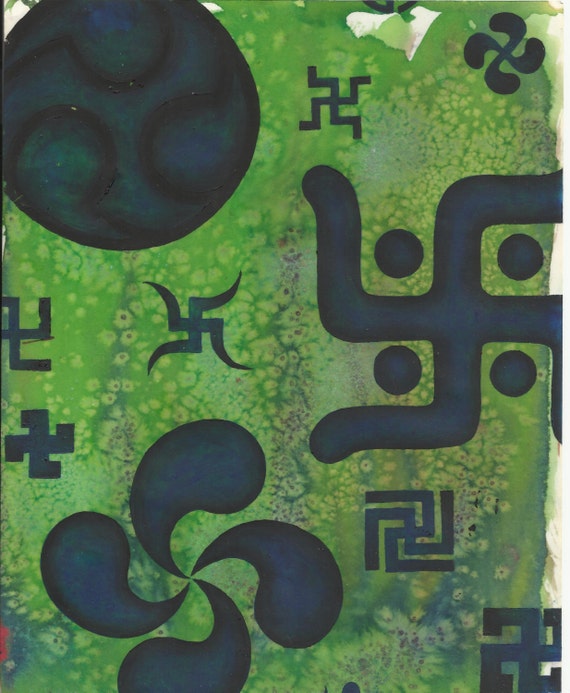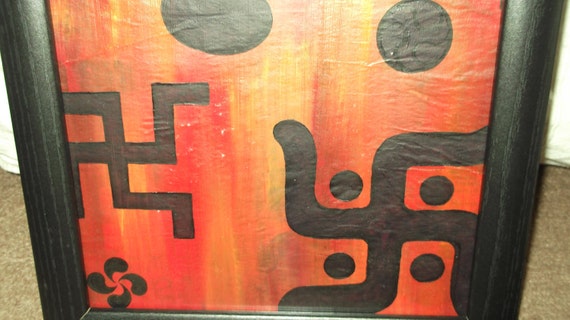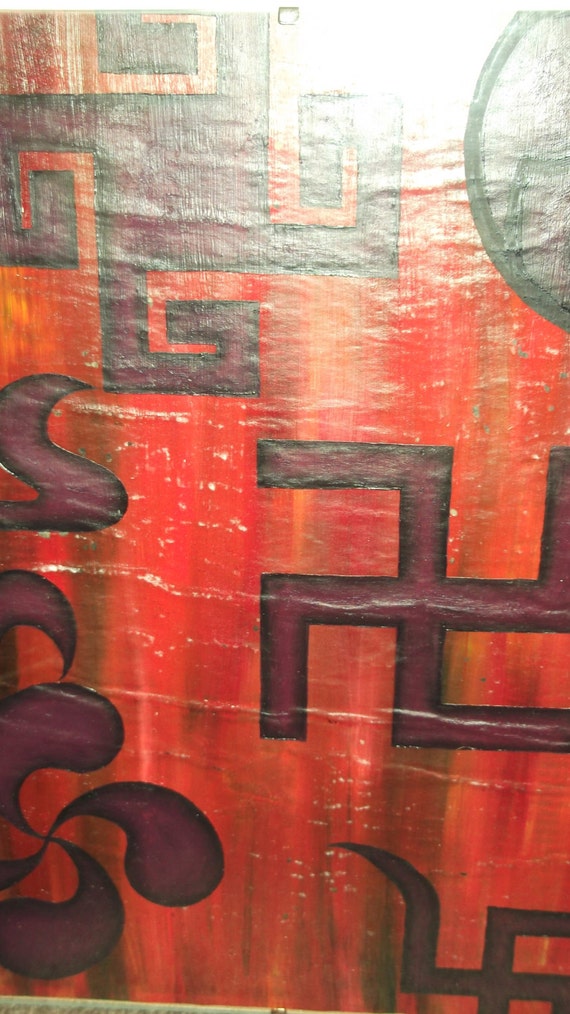Swastika Artwork.
Oil Paintings of Swastika's from Eastern Religions
From LowbrowGirlDesigns
The word "swastika" comes from the Sanskrit svastika - "su" meaning "good," "asti" meaning "to be," and "ka" as a suffix.
This is a three in one. I had a project set for me a few months back to paint some Swastika's for a Buddhist lady. I got slightly carried away after researching and painting the first, witch led to me creating these three pieces.
The first is my favorite.

Also avilable as a print at:
As always I will give you a few tips on how I created the piece.
The background is inked. I used three shades of green inks. Firstly I coated the paper with a thick layer of water, then I layered on the green inks, and finally sprinkled salt over.
To make the shaded effect on the Swastika's I used a flat edge brush. I first used oil paint to fill in the main color, then I went around the edge thinly with black paint. Finally I went over this with a clean brush, just a small amount of white spirit on it, and blended, going round the entire edge, moving inwards as I reached the starting point each time. This is quite difficult but if you keep trying it gets easier.
I used this blending techniques on the following two pieces but the background is different.These backgrounds are oil painted. I simply squeeze plenty of paint onto the surface, in whatever colors desired, and use a thick brush to blend them together. It is important to go from one end to the other without stopping, or starting from the middle. It is also important to only go over each area once or the colors will blend too much and turn brown. Also clean your brush after each turn of once again your colors will blend too much.


I really love these pieces. As I mentioned earlier I became fascinated with Swastikas once I looked into them. As many of you probably have I grew up believing they were a symbol of evil and oppression. I had no idea that they were originally symbols for so much more and something completely different.
The swastika is an ancient symbol that has been used for over 3,000 years. (That even predates the ancient Egyptian symbol, the Ankh!)Swastikas have been used in various cultures and religions around the world including India, Iran,Nepal, China, Japan, Korea and Europe. It remains widely used in Indian religions, specifically in Hinduism, Buddhism, and Jainism. There is even an English and German (good) Swastika.During World War I, the swastika could even be found on the shoulder patches of the American 45th Division and on the Finnish air force until after World War II.Until the Nazis used this symbol, the swastika was used by many cultures to represent life, sun, power, strength, and good luck. There is a great debate as to what the swastika means now. For 3,000 years, the swastika meant life and good luck. But because of the Nazis, it has also taken on a meaning of death and hate.
These conflicting meanings are causing problems in today's society. For Buddhists and Hindus, the swastika is a very religious symbol that is commonly used. Chirag Badlani shares a story about one time when he went to make some photocopies of some Hindu Gods for his temple. While standing in line to pay for the photocopies, some people behind him in line noticed that one of the pictures had a swastika. They called him a Nazi.
Unfortunately, the Nazis were so effective at their use of the swastika emblem, that many do not even know any other meaning for the swastika. Can there be two completely opposite meanings for one symbol?http://history1900s.about.com/cs/swastika/a/swastikahistory.htm
I hope with these pieces i have not only learnt something new but also encouraged others to learn something new. Maybe even created something beautiful.
Thank you for looking and please pop by to my shop for more works of art that are a little bit different.
Also I would really appreciate it if you could like me on Facebook :-)
No comments:
Post a Comment